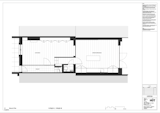A London Townhouse Gets a Gorgeous Renovation That Will Only Look Better Over Time
De Beauvoir Town is a lively neighborhood in trendy East London boasting a village-like atmosphere and a number of early Victorian villas and townhouses—many of which fall into a conservation area. When architect Rachel Eccles, Associate Director at HÛT Architecture, was tasked with renovating a three-story, mid-terrace townhouse for a young creative couple—a musician and a furniture designer—she turned to a simple palette of minimal, handcrafted materials.
"The building sits in a conservation area, and the whole row of terraces is constructed from masonry," says Eccles. "We liked the idea of a robust brick construction as opposed to a lighter-weight material and wanted the extension to have its own identity. So, we selected a brick that had a contemporary, high-craft quality and would age really well over time. I think Victorian and Georgian buildings do look better over time, after they have been lived in and developed a patina."
Robust, handcrafted materials—including terrazzo, black coal-fired bricks, timber, and steel—were selected and used "almost like a rule" throughout the renovation.
The black horizontal bricks are from Petersen Tegl, a Danish brickworks that has been run by the same family since 1791. HÛT Architecture used these bricks to construct the extension, as well as to clad the interior of the fireplace.
Shop the Look
The fireplace, handcrafted by Granby Workshop in Liverpool, is made from recycled building rubble. This material echoes the terrazzo tile used in the bathroom. Likewise, the Douglas fir timber flooring on the ground floor is similar to the timber used to over-clad the original staircase.
"It is one of our principles at HÛT—we pick materials that age well and improve over time," says Eccles. "It shouldn’t look shoddy in five years time, it should get better and better. We want the building to last for another 100 years."
HÛT reconfigured the ground floor layout to create an open-plan social area for entertaining, and this culminates in the full-width kitchen-dining extension at the rear of the home. The extension is light and airy, with high ceilings and details, such as doorways, that extend all the way from floor to ceiling.
The black steel-framed glass partition that separates the living room from the entrance hallway echoes both the steel-framed glass doors that lead from the extension to the patio and the glass shower screens in the bathroom.
The point where the extension meets the boundary wall of the neighboring property was limited to eight feet in height due to planning restrictions. Here, HÛT installed an angled skylight with a ribbon of glazing that maximizes the feeling of volume and brings as much natural light into the interior as possible.
"All you can see through this glass is trees and the sky," says Eccles. "The client is quite a tall guy, so it was important for him to have this sense of space throughout."
The extension is connected to the front of the house via an internal picture window, which maintains clear lines of sight through the entire ground-floor living space.
"It’s about trying to connect the spaces rather than having lots of different rooms," says Eccles. "There are a lot of sight lines running through the space, and you can see right through into the garden beyond."
The connection between the extension and the garden was designed to be as seamless as possible, with a threshold that is almost completely flush. In the winter months, the two spaces are visually connected through the glass windows, and in the summer months the doors can be opened so that the living space extends into the garden.
The upper floor remains true to the original plan of the building, but it has been given a contemporary twist through the use of materials and finishes, including olive green walls and cabinetry in the master bedroom.
HÛT Architecture restored the front facade to its original state, made repairs to the sash windows and brickwork, and installed a new front door. "If you’re a passerby on the street, it still looks like a traditional building," says Eccles.
"We wanted to be sensitive to the existing building, keep what we could, and repair things so that it will last for another 100 years." —Rachel Eccles
"For me, this project was about making everything look simple—and that can sometimes be the hardest thing to do. Having a simple palette of robust, handcrafted materials to begin with helps. It is almost like having a set of rules to work with."
Related Reading:
A Clever Sunken Roof Fills a London Terrace House with Light
A Gracious London Terrace House Is Reborn with Salvaged Materials
A London Terrace House Gets a Luminous Expansion
Project Credits:
Architect of Record: HÛT / @hut_architecture
General Contractor: ASAP Construction Ltd
Structural Engineer: Hardman Structural Engineers
Landscape Design: Tom Massey
Published
Get the Renovations Newsletter
From warehouse conversions to rehabbed midcentury gems, to expert advice and budget breakdowns, the renovation newsletter serves up the inspiration you need to tackle your next project.





















